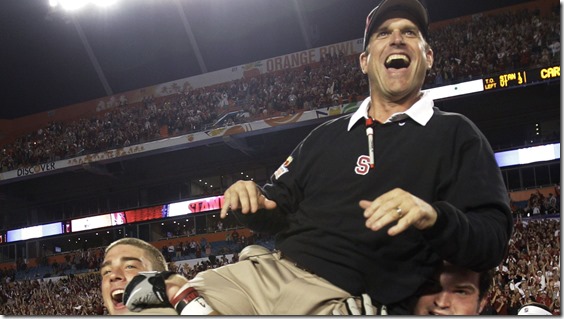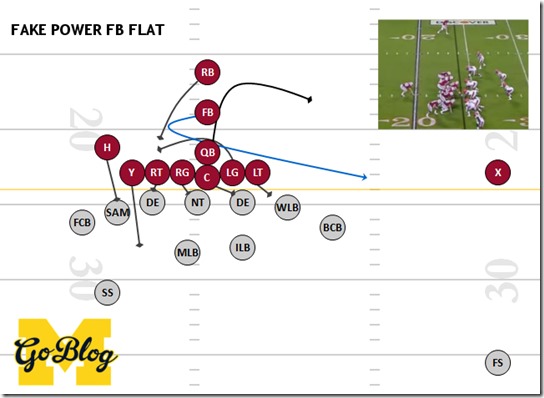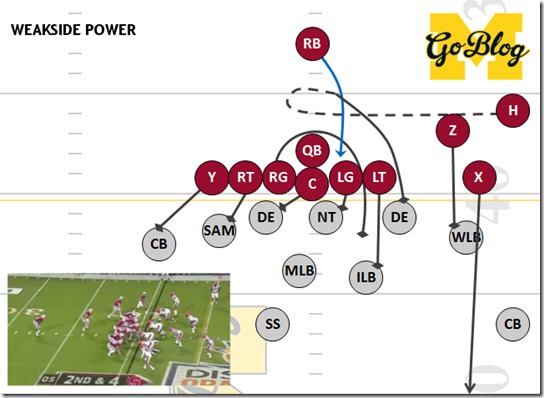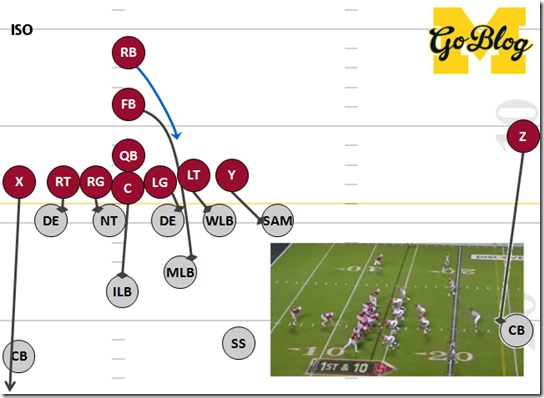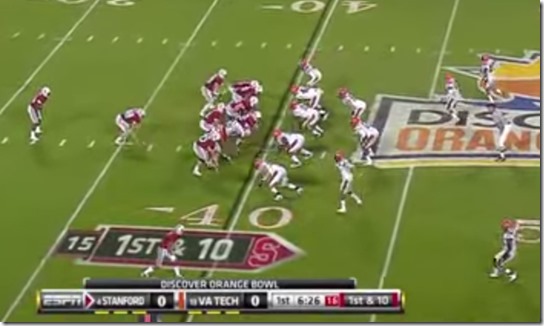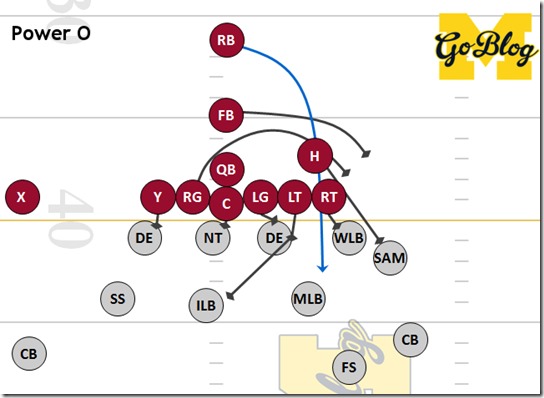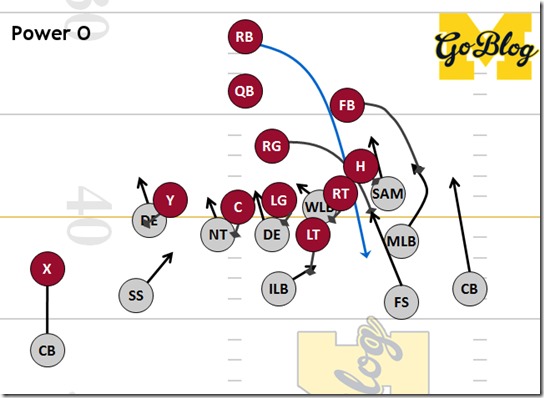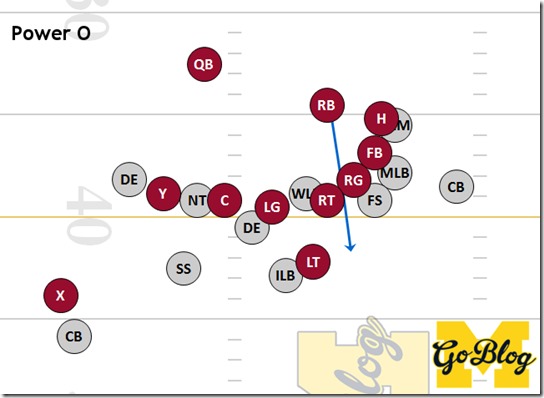META: Okay hivemind, I think I'm gonna break the Tuesday column formerly known as Hokepoints (and Museday) into different columns, alternating between stat stuff and Xs and Os stuff. Gimme name ideas. Jimmystats and Jimmypens? I'm at a loss.
Lynn Sladky, AP via Freep.
In his profile in heroism on Harbaugh yesterday, Brian mentioned that THIS pro-style offense at least sometimes does things other than what the defense wants/expects/prepared for:
Those 5.2s [rushing YPC in 2009, 2010 and 2011 at Stanfard] are crazy given the context—on par with Rodriguez's Denard-era run games minus, you know, Denard. This is not a scheme that's just "run it until you stop it"—Harbaugh is trying to screw with your run fits every play.
I thought I'd get into that screwing just a bit because one thing we haven't seen much of at Michigan is someone who knows how to run a power offense correctly. We've seen DeBord and Borges run it poorly, and we've seen Nussmeier try to mold it onto a horizontal spread while still fulfilling Hoke's mandate that at least one tight end must be doing something he's bad at every play.
For something approximating what I expect Michigan will run I went back to the last game Harbaugh coached in college, the 2011 Orange Bowl. Stanford faced Bud Foster's quarters defense, which is helpful since VT's scheme is from the same tree that Michigan State and Ohio State now run.
This was an evisceration. Stanford called 27 running plays and got 300 yards (8.6 YPC) from them. You can remove garbage time (optional since Harbaugh was still running his offense full-bore at 34-12) and it's still 182 yards on 22 carries, for 8.3 YPC. A lot of those were deep gashes—60 yards, 26 yards, 56 yards—which is what you'd expect against a defense that usually gives its safeties gap assignments. I'll show you how the first of those gashes was set up.
Step 1: Scissors.
The first play from scrimmage Stanford came out in a standard I-formation: inline fullback, tight end off the line. Anyone who's scouted Stanford would guess they're going to run their bread 'n butter play: Power-O. We've been over that one before: the backside guard pulls, everyone else has to pin defenders in their spots, and then that pulling guard and the fullback and the RB all come downhill at the MLB, and the resulting yardage is determined by the resulting collision.
Harbaugh showed it without running it with a clever counter that sold the defense on Power-O then had the FB reverse direction and head into the flat, where the rolling out Andrew Luck had essentially a vertical option play on the isolated DB (I labeled him the BCB but I think I got him and the FS confused on the diagram):
He ran a West Coast play from the shotgun on the ensuing 1st down, and then on 2nd and 4 tried to put a power run on the backside with a pass look:
This was blown up by the MLB shooting the gap abandoned by the pulling right guard. A third down pass attempt was blown up when a blitzer wasn't picked up.
[After the jump: how to make the defense eat rock.]
Step 2: Paper.
Next drive Stanford is out in the Power look again on 1st down. They ran a sorta play-action with the RB and QB but the OL were pass blocking all the way (the pass protection broke down and Luck was chased out of bounds for a 1-yard sack). The rest of the drive is a pass for 6 yards, an incomplete, and a failed fake punt.
First play of the next drive and it's an ISO. Isolation runs are quick-hitters, the success of which is mostly on where the FB impacts the MLB. That complements Power-O well because if the MLB is reading the pulling guard he can get caught on the backside of the play when he needs to be reacting quickly to the play in front of him.
Moreover they've caught Virginia Tech trying to play games. Note the OLBs are both on the strong side of the formation and the backside is left looking weak. The DL would slant to the backside on this play, i.e. away from the side Stanford is running. That makes the key block (the LG vs the DE over him) an easy one and this could be an RB going head first into the secondary, but the LT lost control of his kickout block and the WLB pincered in from behind to keep it to a minimal gain.
Step 3: Candle, Bazooka, Steve Perry, wait, no, what's going on…
ROCK BITCHES!
Note at this point Stanford has yet to actually run their base running play to the base side, and Virginia Tech is already blitzing MLBs and slanting the DL. The next play is a screen from shotgun and then a 3rd down conversion that was 100% Luck being the guy they were about to move Peyton Manning out for.
So now 1st and 10 right after that big conversion, and Stanford immediately comes out in a goofy unbalanced formation, which they then motion into a standard I twins with the TE and RT flipped. Then the H-back (or U-back to use M's old terminology) motioned it into an I-form heavy.
What they've done is create the optimal formation for running their favorite play: Power-O. But instead of just coming out like this and announcing to the world "hey look Erik Magnusson is over here!" this was run immediately out of an amazing 3rd down conversion, and Virginia Tech is given no time to sort things out after all that pre-snap movement:
Power O, because it's more of a pin-and-pull concept than a quick face-slap, will end up working a lot like zone running: covered OL block the guys over them, uncovered OL help those happen then go to the second level, and you block whoever winds up in your grill. This is why having smart Stanford players who've been running it for four years really helps to make it go, as you'll see when the FB and pulling guard get to the edge and start looking for guys to block.
Here Virginia Tech was again slanting. The DL jumps a gap over and the LBs are supposed to scrape over the top. What ends up happening is the DL makes the initial pin blocks easy. The defense can still make the play, but it will come down to whether the LBs can find and fill their gaps before they're popped by the mobile blockers.
The MLB gets to his and meets fullback, but the free release for the LT gave him a perfect angle to seal the ILB. The last gap is the responsibility of the free safety, i.e. the same guy who just came across the formation and was moving about so much in the gif above. That guy eats pulling guard, and it's a big gap and yards.
Here's another video of it, but without the pre-snap stuff.
It's a Lot Like Boxing
Even on replay it's hard to figure out where all of these blocks are occurring and what everyone's trying to do. Virginia Tech's defense was sound—they had defenders for every hole—but the slant and the nature of quarters meant the ILB who had the gap Stanford was hitting would be cut off by a releasing OT, and ultimately the filling safety wound up mano-e-mano with a right guard. I'll try to show you with arrows where everybody thinks they're going:
The FB and RG are free hitters. They block whoever shows.
You know how the spread makes space by having small players force the defense to put fewer big players into the box? Well the concept of Manball is the opposite: your big burly dudes end up plugging their little dudes. The result:
Just look at that and marvel at the personnel matchups he wound up with. The defense's linemen are all on the backside, their momentum and the bodies of blockers between them and the play. And the running lane itself is two OTs and a guard against two LBs and a safety.
Every pound of size/ounce of strength the free safety gives up to that RG blocking him will be another inch of space for the RB to blast through. Lots of ounces and lots of force later, the safety is folded and the RB has a huge gap.
Truly the defense could have done all sorts of thing to make sure it never got to that. But remember they've spent the day so far defending all of these counters to the Power thing, and are trying to be clever, and when Stanford finally does break out the bread 'n butter it's right after some WTF pre-snap stuff.
This is what opponents mean when they say Harbaugh's stuff is exotic even if it's out of the good ol' caveman offense. It's not DeBord, who lined up, waited for the defense to come down, then shifted the fullback to the side that everyone already knew the run was going. It's not Borges, who put Taylor Lewan out there in the role of tackle with an easy job and plowed forward until the defense understood what was happening, and then kept at it until the defense could over-adjust to what was happening, and then scrapped it.
This is boxing. He jabs, comes up, comes low, dances, and then head-fake to the haymaker. Michigan might not have the guys to do it well next year, but given our recent history minus the Rodriguez spell, it'll be quite refreshing to watch an offense that actually tries to put its players in advantageous positions.
